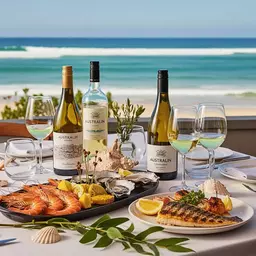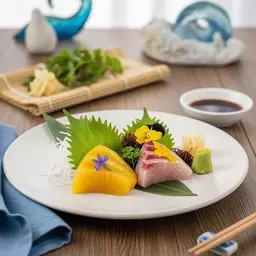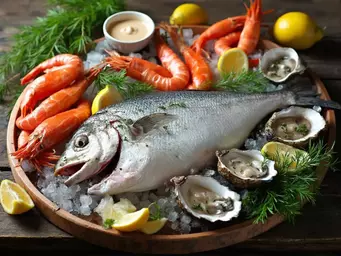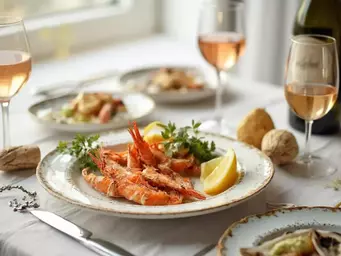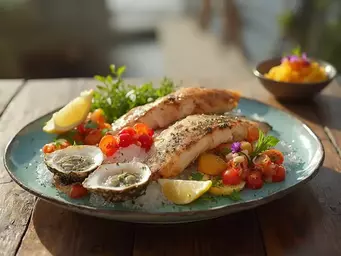Wine and Sustainable Seafood Pairing Tips
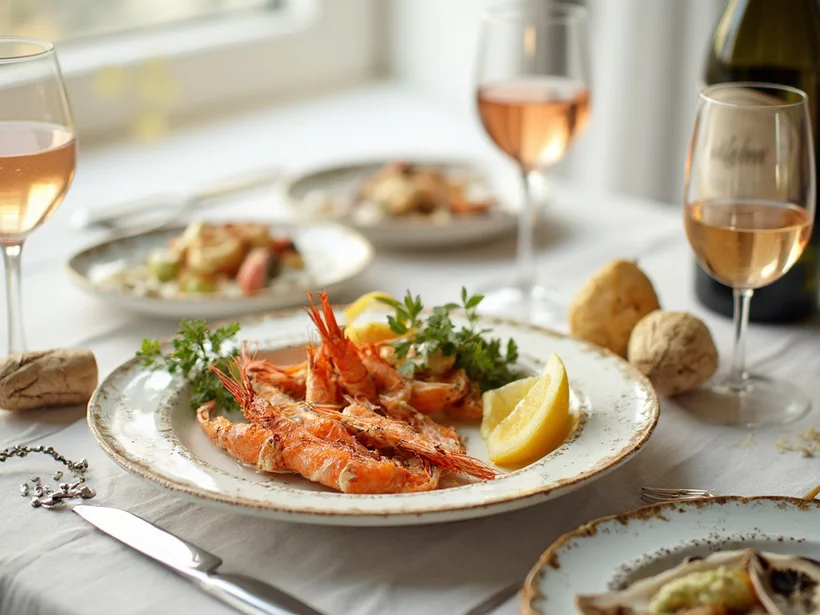
Have you ever paused to consider where your favorite dish truly comes from? The journey from ocean to plate involves not just taste, but also sustainability.
What You Will Learn
- Understanding the concept of sustainable seafood and its significance in preserving marine ecosystems.
- Key characteristics of sustainable seafood, including responsible fishing practices and traceability.
- The positive impact of sustainable practices on marine life and local economies.
- How to identify sustainably sourced seafood through certifications like the Marine Stewardship Council (MSC).
- Tips for pairing sustainable seafood with wines that enhance flavor while supporting local producers.
Making Informed Choices: Sustainable Seafood Practices
Understanding what makes seafood sustainable and why it matters is key to protecting our oceans and supporting responsible practices. This visual breaks down the core elements and their positive impacts.
Impacts on Marine Ecosystems
- Reduces overfishing risk.
- Minimizes environmental footprint.
- Maintains healthy habitats & biodiversity.
Role of MSC Certification
- Promotes global sustainable sourcing.
- Helps consumers identify sustainable products.
- Safeguards oceans for future generations.
Understanding Sustainable Seafood and Its Importance
As we dive into the world of sustainable seafood, it's essential to grasp what this concept truly means. Sustainable seafood refers to fish and seafood that are caught or farmed in a way that ensures the health of our ocean ecosystems and fish populations. This practice not only protects marine life but also supports local fishing communities. At The Yellow Tail Table, we believe it's vital to embrace these practices to enjoy our delicious seafood without compromising the health of our oceans.
In Australia, where our vibrant coastal culture flourishes, understanding sustainable practices can significantly impact our culinary experiences. By choosing sustainable seafood, we support fisheries that prioritize environmental stewardship and responsible harvesting techniques. Have you ever considered the journey your fish took before it reached your plate? Let's explore this further.
What Makes Seafood Sustainable?
Sustainable seafood is characterized by several key factors that ensure its minimal impact on the environment. Here are the main aspects that define sustainability in seafood:
- Responsible fishing practices: This includes methods that prevent overfishing and protect habitats.
- Farmed seafood standards: Sustainable aquaculture focuses on fish farming practices that avoid harming ecosystems.
- Traceability: Knowing where your seafood comes from helps ensure it meets sustainability criteria.
- Regulatory compliance: Following local and national regulations can help maintain healthy fish populations.
By understanding these elements, we can make informed choices that contribute to the sustainability of our oceans. It's exciting to know that our daily decisions can have a lasting impact!
The Impact of Sustainable Practices on Marine Ecosystems
Shifting to sustainable seafood practices can lead to profound positive changes in our marine ecosystems. For one, sustainable fishing reduces the risk of overfishing, which can deplete fish populations and disrupt the balance of marine life. This balance is essential for maintaining healthy habitats and supporting biodiversity.
Furthermore, sustainable aquaculture minimizes the environmental footprint of fish farming. For instance, responsible practices can reduce water pollution and habitat destruction. Every time we choose sustainable seafood, we are not just making a better choice for our health but also for our planet!
Exploring the Role of the Marine Stewardship Council in Promoting Sustainability
The Marine Stewardship Council (MSC) plays a crucial role in promoting sustainable seafood practices globally. This independent nonprofit organization works to ensure that seafood is sourced from environmentally sustainable fisheries. With their well-recognized blue fish label, the MSC helps consumers easily identify products that meet strict sustainability criteria.
By supporting MSC-certified seafood, we contribute to a global movement that safeguards our oceans for future generations. It's a simple choice that aligns perfectly with the mission of The Yellow Tail Table, where we celebrate local produce and sustainable seafood practices in our culinary adventures.
Interactive Poll: Your Seafood Choices Matter!
We want to know your thoughts! How often do you choose sustainable seafood when dining out or cooking at home?
Frequently Asked Questions About Sustainable Seafood and Wine Pairing
- What does "sustainable seafood" mean?
- Sustainable seafood refers to fish and other marine life caught or farmed in ways that do not harm ocean ecosystems or deplete fish populations. It ensures that seafood resources are available for future generations.
- Why is sustainable seafood important?
- Choosing sustainable seafood helps prevent overfishing, protects marine habitats and biodiversity, and supports the livelihoods of fishing communities. It contributes to healthier oceans and a more balanced ecosystem.
- How can I identify sustainable seafood?
- Look for certifications like the Marine Stewardship Council (MSC) blue fish label, which indicates that the seafood comes from a well-managed, sustainable fishery. You can also consult seafood guides or apps provided by organizations like the WWF or Monterey Bay Aquarium.
- What are the key characteristics of sustainable seafood practices?
- Key characteristics include responsible fishing practices that avoid overfishing and habitat destruction, sustainable aquaculture standards that minimize environmental impact, traceability to ensure ethical sourcing, and compliance with regulations designed to maintain healthy fish populations.
- How do I pair wine with sustainable seafood?
- The key to pairing wine with seafood is to balance acidity and tannin levels. High-acidity white wines like Sauvignon Blanc or crisp Rieslings often complement seafood well by cutting through richness. For a deeper understanding of the science behind these pairings, exploring resources such as the chemistry of food and wine pairings can be very insightful. Generally, low-tannin wines are preferred to avoid metallic tastes. Experimentation with different varietals and dishes is encouraged to discover personal preferences.
- Can sustainable practices also apply to wine pairing?
- Yes, supporting sustainable practices extends to wine pairing as well. Choosing local wines from producers who employ sustainable farming methods not only enhances the overall dining experience but also aligns with environmental stewardship. For a guide on responsible wine and seafood pairing, the Aquaculture Stewardship Council (ASC) offers valuable insights.
Summarizing Key Insights on Wine and Sustainable Seafood Pairing
As we dive into the delicious world of wine and sustainable seafood pairing, it’s vital to recognize the significance of supporting sustainable practices. By choosing seafood that is ethically sourced, we help protect our marine ecosystems, ensuring that future generations can also enjoy the vibrant flavors of the ocean. Have you ever thought about the impact of your dining choices on the environment? Every little decision counts!
Moreover, when we pair sustainable seafood with thoughtfully selected wines, we're not just elevating our meals, but also contributing to a larger movement of environmental awareness. In Australia, chefs are increasingly advocating for this cause, making it easier for us to enjoy meals that are both delicious and responsible.
The Importance of Supporting Sustainable Practices
Supporting sustainable practices in our seafood consumption brings many benefits, not just for us but for the planet. Here are a few reasons why it’s essential:
- Protecting Marine Life: Sustainable fishing practices help maintain fish populations and preserve the delicate balance of marine ecosystems.
- Improving Food Quality: Fish sourced from sustainable practices often have better flavor and nutritional profiles, enhancing our dining experiences.
- Supporting Local Economies: By choosing local and sustainable seafood, we help boost our community's economy and foster relationships with fishermen who prioritize ethical practices.
Each of these points illustrates how our choices at the dinner table can resonate far beyond just our plates. At The Yellow Tail Table, we believe in championing these practices to enrich our culinary culture!
Final Thoughts on Wine Pairing Recommendations from Australian Chefs
As we’ve explored throughout this article, Australian chefs offer invaluable insights into crafting perfect wine pairings with sustainable seafood. They emphasize the importance of seasonal ingredients and local wines that complement our unique coastal flavors. For instance, pairing a fresh barramundi with a crisp Australian Riesling can truly enhance the dish.
Remember, these recommendations are not just about taste; they’re about celebrating our rich culinary heritage and sustainability. I encourage you to try these pairings in your own kitchen and discover which combinations resonate best with your palate!
Understanding Flavor Profiles: Balancing Acidity and Tannin Levels in Pairing
Pairing wine with seafood isn’t just about grabbing any bottle; it’s an art that involves understanding flavor profiles. The key is to balance acidity and tannin levels to bring out the best in both the wine and the dish. Here are some tips to keep in mind:
- Acidity: Wines with higher acidity, like Sauvignon Blanc, are fantastic companions for seafood, as they cut through richness and highlight freshness.
- Tannin Levels: Since most seafood is low in tannins, opt for low-tannin wines like Pinot Grigio or even sparkling wines that can enhance the texture and flavor of your meal.
- Experimenting: Don’t be afraid to try unconventional pairings! Sometimes, the most delightful surprises come from stepping outside of traditional norms.
By paying attention to these factors, you can elevate your dining experience, ensuring each meal is a harmonious celebration of flavors.
Engaging with the Culinary Community
As you embark on your adventures with wine and sustainable seafood, I invite you to experiment in your own kitchen! Here at The Yellow Tail Table, we thrive on sharing culinary experiences, and there’s no better way to learn than by trying new things.
Encouraging Readers to Experiment with Wine and Seafood at Home
Why not host a little tasting party at home? Gather your friends and family, and challenge each other to create dishes using local seafood paired with your favorite wines. This is a fantastic way to explore different flavors and learn more about sustainable practices together!
Invitation to Share Your Own Pairing Experiences
I’d love to hear about your own seafood and wine pairing experiences! What combinations have you tried that left a lasting impression? Share your stories with us at The Yellow Tail Table, and let’s celebrate the artistry of Australian cuisine together!
Cooking Classes Focused on Seafood Sustainability and Wine Pairing Techniques
If you’re eager to dive deeper into the world of sustainable seafood and wine pairings, consider joining a cooking class! Many local chefs offer classes that focus on these very topics, providing hands-on experience and expert tips to enhance your culinary skills.
Together, we can elevate our appreciation for modern Australian cuisine and its vibrant flavors. So, what culinary adventure will you embark on next?
Recap of Key Points
Here is a quick recap of the important points discussed in the article:
- Sustainable Seafood: Choose fish that are caught or farmed responsibly to protect marine ecosystems and support local communities.
- Key Characteristics: Look for responsible fishing practices, sustainable aquaculture standards, traceability, and regulatory compliance when selecting seafood.
- Positive Impact: Sustainable practices help maintain fish populations and biodiversity, reducing the environmental footprint of seafood consumption.
- Support Certification: Opt for MSC-certified seafood to contribute to global sustainability efforts.
- Wine Pairing: Balance acidity and tannin levels when pairing wine with seafood for an enhanced dining experience.
- Community Engagement: Experiment with local seafood and wine pairings at home, and connect with chefs and culinary enthusiasts to celebrate sustainable practices.

